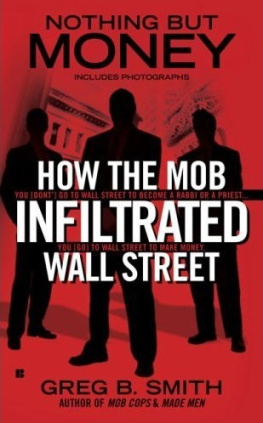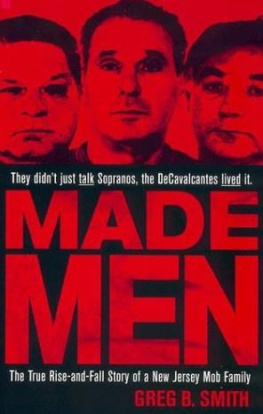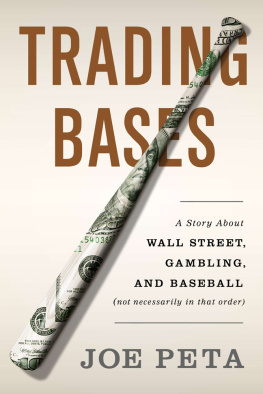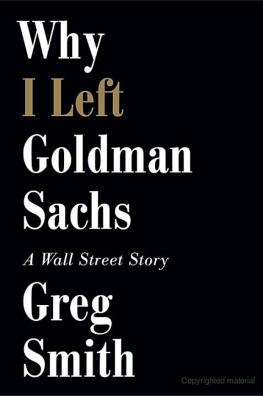Table of Contents
THE BRAINS...
Cary Cimino would supply the Wall Street experience;
Jeffrey Pokross, the brilliant plan.
THE BRAWN...
Robert Lino would offer the aid of organized crime.
The Mob would enforce.
THE BUSINESS...
The buyers on the stock market would never know
what hit them.
Berkley Titles by Greg B. Smith
NOTHING BUT MONEY
MOB COPS
MADE MEN
THE BERKLEY PUBLISHING GROUP
Published by the Penguin Group
Penguin Group (USA) Inc.
375 Hudson Street, New York, New York 10014, USA
Penguin Group (Canada), 90 Eglinton Avenue East, Suite 700, Toronto, Ontario M4P 2Y3, Canada
(a division of Pearson Penguin Canada Inc.)
Penguin Books Ltd., 80 Strand, London WC2R 0RL, England
Penguin Group Ireland, 25 St. Stephens Green, Dublin 2, Ireland (a division of Penguin Books Ltd.)
Penguin Group (Australia), 250 Camberwell Road, Camberwell, Victoria 3124, Australia
(a division of Pearson Australia Group Pty. Ltd.)
Penguin Books India Pvt. Ltd., 11 Community Centre, Panchsheel Park, New Delhi110 017, India
Penguin Group (NZ), 67 Apollo Drive, Rosedale, North Shore 0632, New Zealand
(a division of Pearson New Zealand Ltd.)
Penguin Books (South Africa) (Pty.) Ltd., 24 Sturdee Avenue, Rosebank, Johannesburg 2196,
South Africa
Penguin Books Ltd., Registered Offices: 80 Strand, London WC2R 0RL, England
In an effort to safeguard the privacy of certain people, some individual and place names and identifying characteristics have been changed. Events involving the characters and places happened as described. The publisher does not have any control over and does not assume any responsibility for author or third-party websites or their content.
NOTHING BUT MONEY
A Berkley Book / published by arrangement with the author
PRINTING HISTORY
Berkley mass-market edition / June 2009
Copyright 2009 by Greg B. Smith.
All rights reserved.
No part of this book may be reproduced, scanned, or distributed in any printed or electronic form without permission. Please do not participate in or encourage piracy of copyrighted materials in violation of the authors rights. Purchase only authorized editions.
For information, address: The Berkley Publishing Group, a division of Penguin Group (USA) Inc., 375 Hudson Street, New York, New York 10014.
eISBN : 978-1-101-06006-3
BERKLEY
Berkley Books are published by The Berkley Publishing Group,
a division of Penguin Group (USA) Inc.,
375 Hudson Street, New York, New York 10014.
BERKLEY is a registered trademark of The Berkley Publishing Group.
The B design is a trademark of The Berkley Publishing Group.
Most Berkley Books are available at special quantity discounts for bulk purchases for sales, promotions, premiums, fund-raising, or educational use. Special books, or book excerpts, can also be created to fit specific needs.
For details, write: Special Markets, The Berkley Publishing Group, 375 Hudson Street, New York, New York 10014.
http://us.penguingroup.com
AUTHORS NOTE
Long before U.S. taxpayers began bailing out Wall Street with billions of their hard-earned dollars, there was the original Black Friday of 1869. It was spectacular and disastrous and caused millions in losses to investors from coast to coast, and it was mostly the work of one manJay Gould. When he died of tuberculosis at age fifty-six, one of his peers told reporters assembled on the doorstep of his Fifth Avenue mansion, Wall Street has never seen his equal and never will.
In 1869 Gould was one of the richest men in America, a man who controlled one out of every ten miles of railroad in the nation. Although he was truly a very wealthy man, wealth has a way of making its owners believe there is always a little more just down the road. The source of just a little more, Gould decided, was gold.
His scheme was simple but inspired. He would run up the price of gold, which would, in turn, pump up the price of wheat. Western wheat farmers would then sell their wheat as fast as they could, which would require wheat to be transported East over Goulds railroads. He was counting on fear and greed to line his pockets. It was a clever idea, and therefore, it turned into one of the worst financial disasters in Wall Street history.
Gould and his co-conspirators began buying up gold, inspiring others who saw his investment choices as a bellwether to jump in, too. The price of gold began to rise at an alarming pace, awakening the administration of Ulysses S. Grant from its slumber. President Grant then tried to put the brakes on the runaway train, ordering a major sell-off of government gold.
The sell-off had a different effect. That morning gold had reached a peak of $162. The White House sell message reached Wall Street at five minutes past noon that Friday, September 24, 1869, and within 15 minutes the price of gold had dropped to $133. In the words of the Brooklyn Eagle, Half of Wall Street was ruined.
In a system that relies on self-interest, these things are bound to happen. Gould had his reasons and explanations for his behavior, and he sought to make the case that he was just doing what capitalism demanded. Of course, this was not to be the final Black Friday or Unholy Thursday or Bloody Monday or whatever other modifier the press could dream up to illustrate the shock and horror of a sudden and allegedly unexpected crash. There would be many more, and although results of these market corrections were often differentsometimes the crash lasted awhile, sometimes there was a quick reboundthe underlying explanation often seemed quite similar. Everybody saw a run-up and wanted to get theirs before the money stopped flowing. Sometimes that involved cutting corners here and there. Sometimes that involved breaking laws. But the logic of Wall Street was consistentif everybody else is doing it, Id be a fool not to.
Such was the case during the dot-com craze of the late 1990s, a time of irrational exuberance that, looking back, now seems merely irrational. This was a time when small companies with absolutely no assets went public and money fell from the sky. This was the dawn of pump and dump, when the American Mafia decided it was time to take what they could out of Wall Street. It didnt last long. Just as Jay Goulds brilliant idea became Black Friday back in 1869, the party ended in a bad way. But if you were there when it all took off, for a while it seemed like there was nothing but money.
Greg B. Smith
March 9, 2009
CHAPTER ONE
December 17, 1987
Arthur Kill Road is the far end of nowhere in New York City. Running along the western edge of New Yorks smallest borough, Staten Island, it is not what youd call a tourist destination. The camera-wielding busloads that flood Manhattan religiously check out the Statue of Liberty, the Empire State Building, the Brooklyn Bridge. These are icons meant for collecting. Tourists might even hop the ferry to Staten Island, but thenimmediatelyreturn to Manhattan. If any out-of-towner found himself on the winding curves of Arthur Kill Road heading into the heart of Staten Island, the borough of landfills and subdivisions, he would only be there because he got lost. Very extremely lost. There is really no reason to go there if you are a tourist, or even a regular person. There are no pleasant sights to see. There are no hip restaurants, no cutting-edge galleries, no timeless museums. This is the working edge of New York. This is where people dump things.











